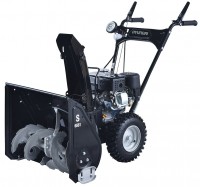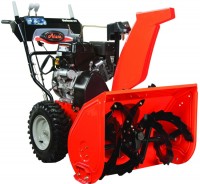Hyundai S6561
 | Outdated Product Motor type: petrol; Working width (cm): 61; Snow height (cm): 51; Adjustable throw direction; Throw distance adjustment; Max. throw distance (m): 11; self-propelled; lights; Number of gears: 4 forward / 1 back; Motor power (hp): 6.5; Motor power (W): 4800; Starter: electric starter (mains 230 V) |
Hyundai S6561 | ||||||||||||||||||||||||||||||||||||||||||||||||||||||||||||
|
| |||||||||||||||||||||||||||||||||||||||||||||||||||||||||||
Always clarify the specifications and configuration of the product with the online store manager before purchasing.
Catalog Hyundai 2025 - new arrivals, bestsellers, and the most relevant models Hyundai.
Reliable and compact device for cleaning the area from snow
The Hyundai S6561 snow blower is equipped with a 6.5-horsepower engine running on AI-92 gasoline. It is driven by wheels (4 gears forward and 1 reverse) and augers. The augers have an “aggressive” shape, thanks to which the device perfectly “chews” not only freshly fallen snow, but also compacted layers with a light ice crust. Snow removal up to 20 cm thick can be done at medium speed, and for snow from 21 to 51 cm thick, use low gears, moving at a slow pace. Soft snow is thrown up to a distance of 11 m. The direction and distance of the throw can be changed by turning the chute manually. The snow blower is quite compact and has a relatively light weight (61 kg), as for equipment of this power class, which allows you to more freely manoeuvre in yards, parking lots and other "narrow" places. To work in the dark or during snowfall, a small LED lamp is installed on the snow blower.
Snow blower for Santa Claus
This snow blower is equipped with a Hyundai ICW 200 “branded” engine. This is a “winter” version of the IC 200 engine, a very reliable, time-tested engine that is installed on two-wheel tractors, cultivators and gasoline lawn mowers from different manufacturers. The guaranteed service life of this engine claimed by the manufacturer is 2000 hours — a very long resource, almost at the level of "professional" equipment. The "winter" version, which is used on Hyundai snow blowers, is distinguished by the presence of carburetor heating. It provides confident start of the motor at temperatures up to -30 °C. Therefore, even in Siberia or beyond the Arctic Circle, problems should not arise during the operation of this equipment.









